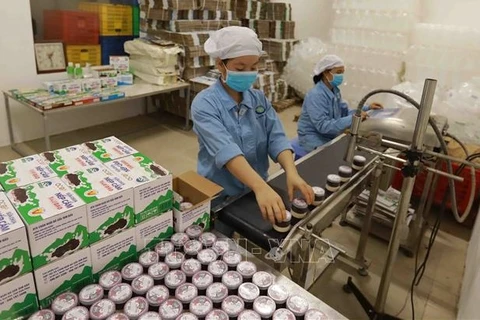 The livestock industry accounted for 25.2% of the agricultural sector's GDP with a steady growth of 4-6% each year over the past 10 years. (Photo: nongnghiep.vn)
The livestock industry accounted for 25.2% of the agricultural sector's GDP with a steady growth of 4-6% each year over the past 10 years. (Photo: nongnghiep.vn) Deputy Minister of Agriculture and Rural Development Phung Duc Tien made the statement at a conference on building the livestock value chain held in Hanoi on October 27.
Tien proposed enterprises producing the same product as well as operating in the same value chain strengthen their cooperation in production and business. That would help the agriculture sector reach targets set out in the sector's development strategy.
"It needs to set up strategies and create a close connection between State management agencies and the commodity associations. This will improve the position and role of the associations and also exploit all potential of the industry," Tien said.
Duong Tat Thang, director of the ministry's Department of Livestock Production, said that the domestic livestock industry still has a lot of room for development because it has a large consumer market at home with nearly 100 million people, and the neighbouring China market. However, the industry still has many limitations, so not yet reaching requirements in the region and the world.
The livestock industry is requested to focus on improving quality and value for meeting the demand for delicious and clean food. This requires the industry to build a value chain of livestock products, ensuring quality, food safety and hygiene.
Nguyen Xuan Duong, deputy chairman of the Vietnam Livestock Association, said the livestock industry now has a strategic orientation, specific plans, solutions and a relatively complete legal framework.
The livestock sector has key products, such as pork, poultry meat and eggs; beef and milk; birds nests; and bees. It must have a chain-based development strategy for each product line, he said.
Nguyen Thanh Son, chairman of the Poultry Breeding Association, said the industry needs to determine key products in the next 10-20 years, production and consumption scale, and the role of parts in the chain, including enterprises, farmers, and cooperatives.
At present, foreign-invested enterprises are gradually occupying both domestic and export market share of the livestock sector.
Sơn has suggested that the Ministry of Agriculture and Rural Development create a favourable mechanism for commodity associations and enterprises to develop the livestock industry.
Vietnam has no law on associations, so the ministry is requested to issue regulations and mechanisms for the operation of associations in agriculture.
Tien said the livestock industry has a relatively complete institutional framework, including the Law on Livestock, three decrees, five circulars, one development strategy of the livestock industry, and one sustainable development strategy on agriculture and rural areas.
From 2010 to 2021, the industry saw an increase of 1.7 times in meat production, 2.7 times for eggs, four times for fresh milk, and about two times in animal feed. The output of meat, eggs and dairy basically met the needs of nearly 100 million people and 17 million tourists each year.
"The livestock accounted for 25.2 per cent of the agricultural sector's GDP with a steady growth of 4-6% each year over the past 10 years," said Tien.
However, Vietnam's livestock production still faces challenges in terms of diseases, climate change and natural disasters, as well as fluctuations in the market for raw materials for animal feed.
Meanwhile, Nguyen Van Trong, deputy chairman of the Vietnam Farms Association, said domestic enterprises have not yet seen the benefits of joining the association, causing the number of members to fall.
Trong said the associations should promote cooperation with cooperatives and farmers. They also need to coordinate with the Department of Livestock Production to build a traceability system./.
VNA
























